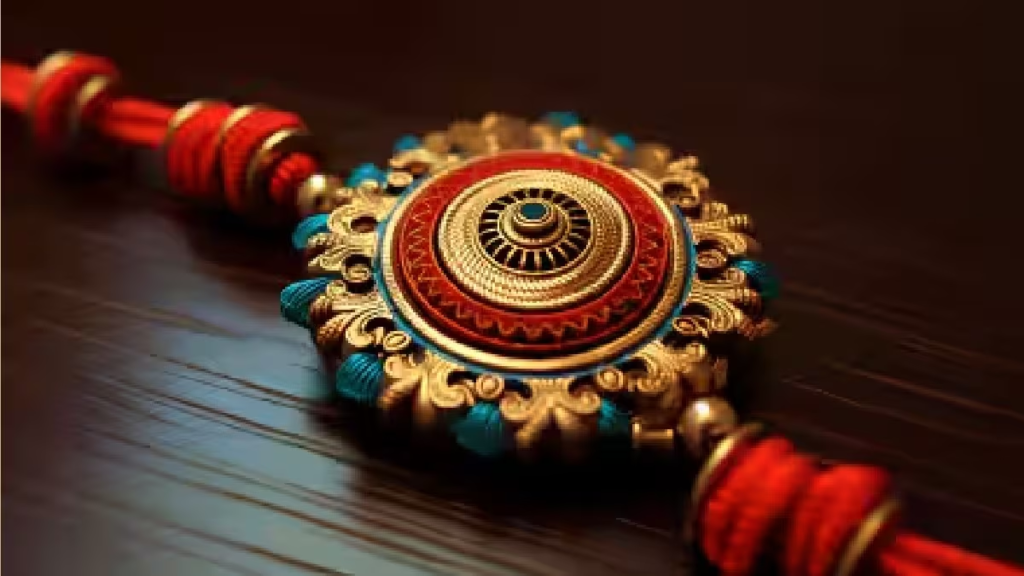
Table of Contents
- Introduction: More Than a Thread
- Mythological Roots: Divine Bonds and Ancient Legends
- Historical Tales: Sisters, Kings, and Empires
- Raksha Bandhan in Literature and Folklore
- The Cultural Canvas: Regional Variations and Customs
- The Festival in the Modern Indian Family
- Rakhi Goes Global: Celebrating Beyond Borders
- Digital Age Rakhis: E-Commerce, Virtual Rakhi & DIY Trends
- Raksha Bandhan as a Symbol of Social Harmony
- Conclusion: A Timeless Bond, Ever Evolving
1. Introduction: More Than a Thread
Raksha Bandhan, at first glance, appears as a simple ritual — a sister tying a rakhi on her brother’s wrist. But beneath this sacred thread lies centuries of transformation, symbolism, and emotional depth. What began in the folds of mythology has now become a multifaceted celebration in modern India and beyond.
2. Mythological Roots: Divine Bonds and Ancient Legends
The earliest whispers of Raksha Bandhan echo through ancient scriptures:
- Draupadi and Krishna: Perhaps the most popular tale. When Draupadi tore a piece of her saree to bandage Krishna’s bleeding finger, he vowed to protect her for life — a bond beyond blood.
- Indra and Sachi: In the Rigveda, Indra’s wife ties a protective thread for his victory in battle, believed to be a precursor to the festival.
- Yama and Yamuna: The god of death promised immortality to his sister Yamuna after she tied a rakhi to him.
These stories weren’t just about protection — they honored trust, loyalty, and unbreakable emotional ties.
3. Historical Tales: Sisters, Kings, and Empires
Moving from myth to monarchy, Raksha Bandhan shaped real-world history:
- Rani Karnavati & Humayun: When Mewar faced threat from Bahadur Shah, the widowed queen sent a rakhi to Mughal emperor Humayun. Touched by the gesture, he marched with his army to defend her honor.
- The Rajput Tradition: Many Rajput queens tied rakhis to neighboring rulers as strategic gestures of alliance and protection.
Rakhi was not just ceremonial — it was diplomatic, poetic, and at times political.
4. Raksha Bandhan in Literature and Folklore
Indian poets and writers across generations have used Raksha Bandhan as a metaphor:
- Rabindranath Tagore used the festival during the Bengal partition to promote Hindu-Muslim unity.
- Folk songs in Punjab, Gujarat, and Bihar sing of the emotional longing of sisters whose brothers live far away, romanticizing the simplicity of the bond.
It’s not just a festival; it’s a storytelling tradition.
5. The Cultural Canvas: Regional Variations and Customs
Across India, Raksha Bandhan takes many avatars:
- In Maharashtra, it merges with Nariyal Purnima, a festival for fishermen.
- In Nepal, it’s celebrated as Janai Purnima, where men also change their sacred thread.
- In South India, the concept exists but is often more spiritual than fraternal.
Different threads, same heart.
6. The Festival in the Modern Indian Family
In today’s homes, Raksha Bandhan is as much about celebration as it is about connection:
- Gifts have evolved from sweets to gadgets.
- Sisters now often tie rakhi to sisters, friends, or even to themselves in symbolic self-love.
- Families separated by distance often come together online, preserving the warmth of tradition.
7. Rakhi Goes Global: Celebrating Beyond Borders
With the Indian diaspora growing, Raksha Bandhan has found new homes in:
- The United States and Canada, where cultural fests in temples and community centers are organized.
- Europe and Australia, where rakhi reaches siblings by post or Amazon delivery.
- Even non-Indians adopt the tradition in multicultural friendships.
It’s a global bond, stitched by shared emotion.
8. Digital Age Rakhis: E-Commerce, Virtual Rakhi & DIY Trends
Tech has redefined how we celebrate:
- Virtual Rakhi ceremonies on video calls.
- E-rakhis with QR codes linking to personal videos or playlists.
- DIY kits and eco-friendly rakhis that encourage creativity and sustainability.
The spirit is the same, the medium has evolved.
9. Raksha Bandhan as a Symbol of Social Harmony
Today, many use Raksha Bandhan as a vehicle for change:
- Tying rakhis to soldiers, police officers, frontline workers.
- Schools organizing events to teach children values of care, trust, and mutual respect.
- Interfaith celebrations promoting peace between communities.
Rakhi now ties hearts, not just wrists.
10. Conclusion: A Timeless Bond, Ever Evolving
From divine scriptures to digital screens, Raksha Bandhan has traveled centuries without losing its soul. Its form has changed, but its essence — a promise of love, trust, and protection — remains untouched.
In an ever-changing world, Raksha Bandhan reminds us that some bonds don’t just withstand time — they grow stronger with it.

